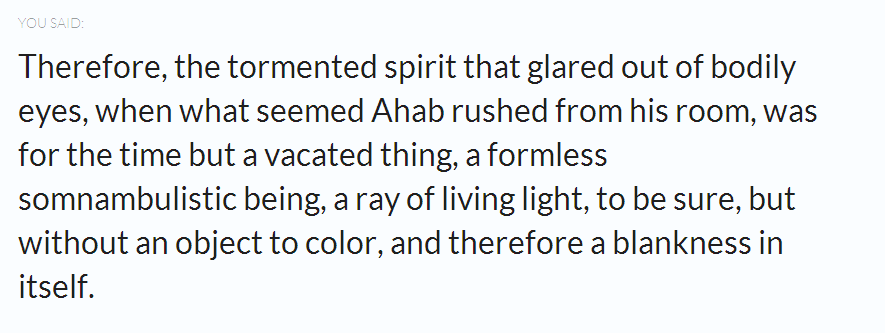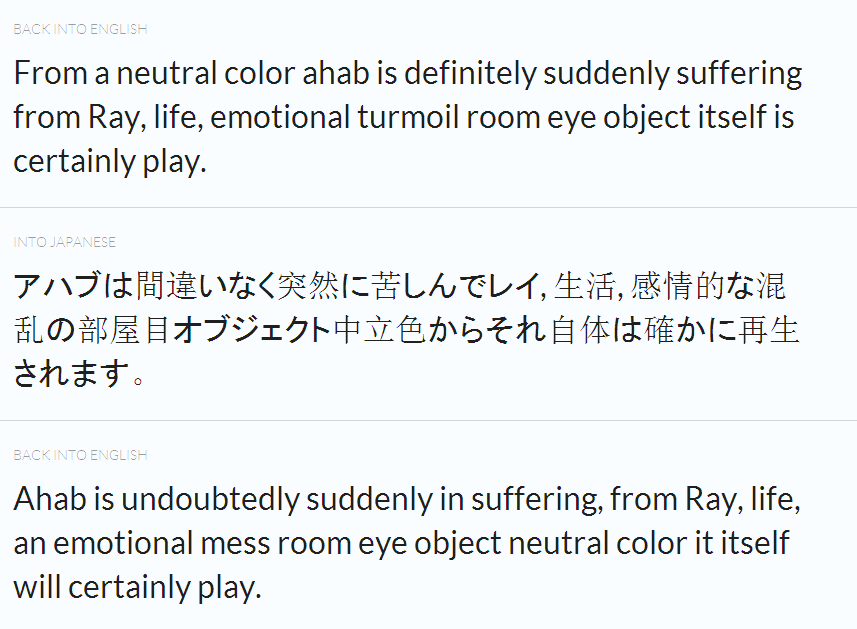Translation Party!: Hack Lab Report
Translation Party is a site that employs the Google language translation tool to translate a sentence from English to Japanese, back to English, and so forth until the input and the output yield the same result which the Translation Party tool calls “Equilibrium.” The novelty of the Translation Party tool is that through finding a one-to-one translation, the user can see how the chosen sentence would read were it transmutable between the two languages. Translation Party is a recent tool (developed in the last five years) which is primarily designed for observing how meaning gets “lost in translation.” The tool lends itself to the nascent territory of Digital Humanities when, applied to an academic agenda, its tacit inability to reach an equilibrium retaining original meaning exposes the importance of nuanced, culturally specific idioms in literature. It is precisely through the exposure of semantic gaps by Translation Party that we are able to glean meaning from what seems at first like a tautological exercise.
In our Translation Party Hack Lab we chose passages from Melville’s Moby Dick and noted the semantic distortion resulting from translation when the passage reached (or failed to produce) an equilibrium. Most students could not resist choosing a particularly idiomatic or circuitous passage from the novel to test. The failure of Translation Party to reach equilibrium where meaning was not distorted far from the original import of the narrative passage was ironically also what helped identify and exemplify one of the salient features of Ishmael’s narration: the struggle with ineffability.
The translation of American Sailors’ patois into Japanese rarely yielded an equilibrium containing the same impressionistic nuances so crucial to Ishmael’s narration. Watch how Translation Party makes its way toward equilibrium (or lack thereof), beginning with the following passage:
 (Melville, 202)
(Melville, 202)
Here is the passage after a few oscillations:

With each step towards a one-to-one translation you can observe how the message of the passage starts to become convoluted, deconstructing the impressionistic tone of Ishmael’s narration. These misaligned reiterations however, are intrinsically rewarding to the close reader for what they do retain. Whether significant in adherence to a scientific approach, the translations above maintain words and clauses that spark imaginative thinking, such as “Ahab is undoubtedly suddenly in suffering… life, an emotional mess…”
The final outcome of my Translation Party is null; the “party is busted” due to an inability to reconcile the passage into a phrasing mutually intelligible to both languages:

The problematic nature of translation has always been a central concern of textual interpretation. Any narrator has a specific literary voice and style that includes tools such as metaphor. Literary tools are dependent on cultural idioms that may not translate; literary tools create “gaps” in meaning where the circuitous language employed does not hold fast in a different language. For the same reason that it is said that to truly read the Qu’ran one must approach the text in its original language of Arabic, Translation Party showed us that Moby Dick must be approached in its original context of American English.
Trying to translate Melville’s work with this digital tool brought to the forefront of the lab the issue of relativity. In a supplementary activity during the Translation Party lab we listened to a Radiolab podcast about the relativity of the color spectrum across animal species, showcased in the example of the mantis shrimp’s ability to see colors far beyond the spectral range of the human eye. I wanted to know what spectral visibility differences might look like between humans who see in full-color, and humans who are colorblind. I got to browsing and found this photo on colourblindawareness.org:

Imagine trying to describe the scene on the left (a person who sees in full-color) to the person who is seeing what is portrayed by the scene on the right. This frustration encapsulates the ineffability Ishmael struggles with in his narration. The same way that a translation of our passage changed the impressionistic color of narrative description, the translation of a photograph to a limited color spectrum changes the impressionistic color of the image without really changing the structural qualities. Ishmael’s portrait of Ahab too, is contingent upon such delicate and untranslatable impressions; Ahab is, as the passage itself suggests “… a ray of living light, to be sure, but without an object to color, and therefore a blankness in itself” (202).
The message of both the podcast as well as the Translation Party was this: what we see is not what other’s see, whether it’s across languages, cultures, or species. The Translation tool fails to illuminate the narrative of Moby Dick in itself, but in its failure helped us diagnose how Ishmael’s impressionistic, looming narration imparts meaning.